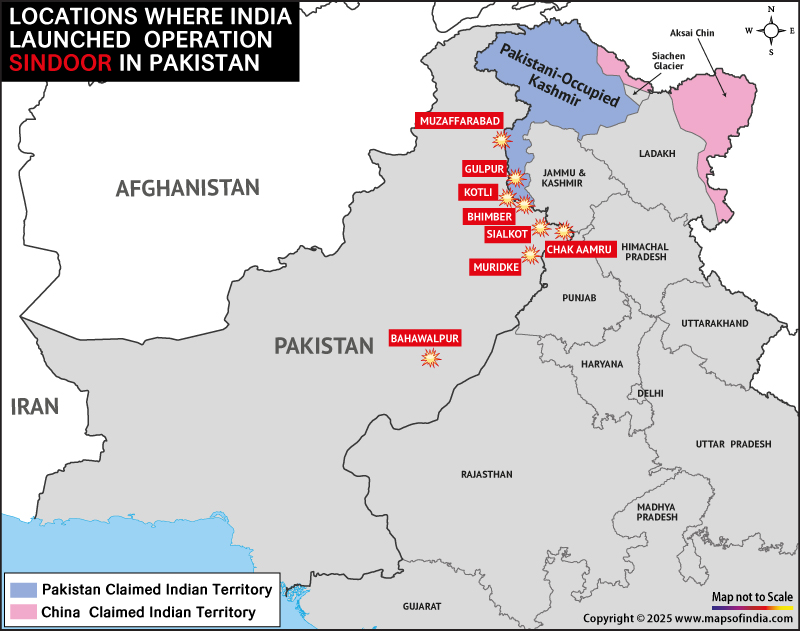
In the early hours of May 6–7, 2025, the Indian Armed Forces launched a carefully coordinated military campaign known as “Operation Sindoor.” This large-scale aerial offensive targeted multiple terrorist camps and infrastructure located within Pakistan and Pakistan-administered Kashmir. The operation was executed as a direct and decisive response to the horrific Pahalgam terrorist attack that took place on April 22, 2025. That attack resulted in the tragic loss of 26 innocent lives, most of whom were Hindu pilgrims and tourists visiting Indian-administered Kashmir. In light of the severity of the incident and mounting public outrage across the country, the Indian government authorized a swift retaliation, aiming to dismantle key terror networks. Operation Sindoor marked a significant escalation in regional tensions and underscored India’s zero-tolerance policy toward cross-border terrorism.
Operation Sindoor: A Response to the Pahalgam Tragedy
In the early morning hours between May 6 and 7, 2025, India launched a bold and decisive military initiative named Operation Sindoor. This mission was a direct response to the brutal terrorist attack that had taken place in Pahalgam just days earlier, where 26 innocent Hindu pilgrims lost their lives in a premeditated assault carried out by armed militants. Following extensive investigations by Indian intelligence and security agencies, credible evidence emerged pointing to the involvement of Pakistan-based terrorist organizations. These findings left the Indian government with no choice but to take firm and immediate action to neutralize the threats emanating from across the border. Operation Sindoor was therefore initiated not only to bring justice to the victims of the Pahalgam tragedy but also to dismantle the infrastructure that enables such acts of terror, reinforcing India’s resolve to protect its citizens and sovereignty.
How Operation Sindoor Unfolded
On May 7, Indian Air Force Rafale jets completed operation in 23 minutes, deploying SCALP missiles and AASM Hammer bombs.The operation targeted nine areas across Pakistan and Pakistan-administered Kashmir, including Tehra Kalan Bahawalpur, Muridke, Sialkot, Bhimber, Kotli, and Muzaffarabad. These locations were known to be key strongholds of militant organizations like Lashkar-e-Taiba, Jaish-e-Mohammed, and Hizbul Mujahideen. India stated that the strikes were carefully planned, focusing solely on terrorist infrastructure while avoiding harm to civilian and military sites in Pakistan. The mission is reported to have killed over 70 militants.
Pakistan’s Response and Claims
Pakistan has strongly condemned the missile strikes as an “act of war,” accusing Indian missiles of targeting civilian areas, including a mosque in Bahawalpur. This attack led to the death of 26 civilians and injured 46 others. The Pakistani military claimed to have shot down five Indian aircraft, including Rafales and a drone. In retaliation, Pakistan initiated artillery shelling along the Line of Control, resulting in the deaths of three Indian civilians.
According to government sources, India carried out 24 missile strikes on nine locations across Pakistan and Pakistan-Occupied Kashmir as part of Operation Sindoor, which was a response to the Pahalgam terror attack. The strikes reportedly killed 70 terrorists. The operation was described as not only a military action but also a declaration of strategic resolve.
Implications and The Path Forward
Operation Sindoor stands as a strong testament to India’s unwavering commitment to fighting terrorism and ensuring the safety and security of its citizens. At the same time, it brings to light the fragile and often volatile nature of India-Pakistan relations, underlining the ever-present danger of conflict escalation in the region. In the aftermath of this military action, it becomes even more essential for both nations to prioritize constructive diplomatic engagement, work towards rebuilding mutual confidence, and reaffirm their shared responsibility in striving for lasting peace and stability in South Asia. A sustained focus on dialogue, cooperation, and peaceful conflict resolution is vital to preventing further tensions and nurturing a future built on understanding and coexistence.
Conclusion
Operation Sindoor represents a significant escalation in the ongoing tensions between India and Pakistan, highlighting India’s firm position against cross-border terrorism. The operation’s rapid and precise execution reflects significant progress in both military strategies and technological capabilities.
However, the subsequent exchange of fire and the spread of AI-driven misinformation underscore the complexities of modern warfare, where battles are fought both on the ground and in the digital realm. As the situation remains volatile.